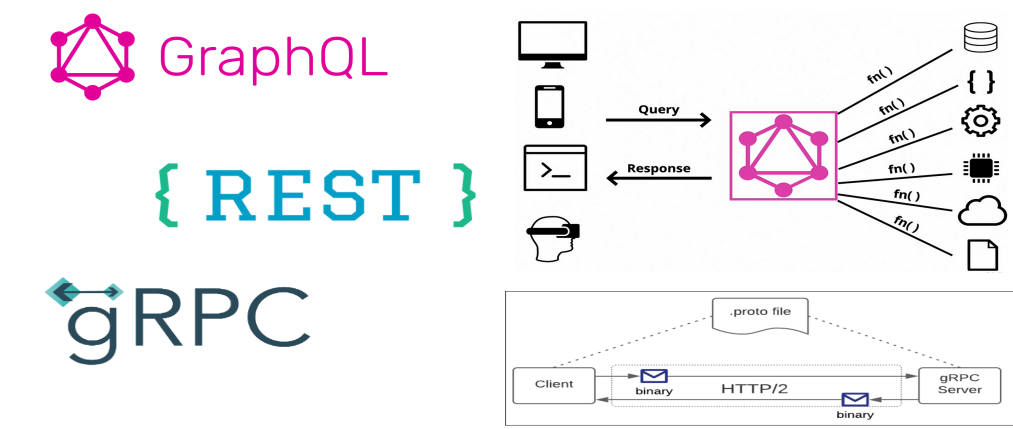APIs are vital for creating modern digital experiences that can be accessed easily, customized, and securely integrated with backend systems. APIs are the modern equivalent of “plug and play” connectors in software. They simplify how systems communicate, offering flexibility and independence within an enterprise.
The API landscape is constantly evolving, with new tools and trends emerging to shape the way we build and consume data. One of the most significant decisions as part of building APIs is selecting the API architectural style you will be using. But even amidst this change, three technologies stand out as the reigning champions: REST , GraphQL , and gRPC . Each boasts unique strengths and weaknesses, making the decision of which one to use a strategic challenge. This detailed exploration aims to provide a comprehensive understanding of these technologies, highlighting their comparative advantages, disadvantages, and optimal use cases to inform a strategic decision-making process.
REST - The Timeless Standard
REST - Advantages
- Mature and widely adopted: REST benefits from a broad base of support, including extensive documentation, a plethora of tools, and a robust community, ensuring a well-trodden path for development.
- Simple and flexible: Easy to understand and implement, especially for smaller APIs.
- Stateless: By treating each request as an independent transaction, REST achieves high scalability and resilience to server disruptions.
- Multiple media types: Supports JSON, XML, and other formats enhancing its versatility.
REST - Limitations
- Overfetching and underfetching: Can send unnecessary data or require multiple requests for related data impacting performance and user experience.
- Versioning complexities: Requires careful versioning management to avoid breaking changes for ever-evolving APIs.
- Limited real-time capabilities: Not ideal for applications requiring continuous updates.
REST - Best Use Cases
REST, the veteran of the group, continues to enjoy widespread adoption and mature tooling. Its simplicity and well-defined principles resonate with both clients and developers, making it an ideal choice for:
- Public APIs: Its flexibility caters to diverse needs, and its stateless design ensures scalability for high traffic.
- Simple CRUD operations: Clearly defined resources and well-understood interactions optimize development time.
- Limited real-time requirements: For scenarios where dynamic updates aren’t essential, REST offers stability and ease of use.
REST - Considerations
- Pay attention to versioning and scalability for large user bases.
- Evaluate overfetching and underfetching impact on performance and data usage.
GraphQL - The Dynamic Orchestrator
GraphQL - Advantages
- Client-driven data fetching: Allows clients to request only the data they need, reducing overfetching.
- Complex data relationships: Efficiently handles nested data through a single request.
- Real-time updates: Supports subscriptions for push notifications on data changes.
- Flexible schema: Adapts to evolving data needs without breaking clients.
GraphQL - Limitations
- Increased server complexity: Requires additional server-side development effort for schema management and validation.
- Learning curve: Requires familiarity with the GraphQL query language for both clients and developers.
- Evolving tooling landscape: While the tooling ecosystem has grown significantly, it’s still not as mature as REST’s.
GraphQL - Best Use Cases
GraphQL empowers clients to request only what they need, reducing overfetching and optimizing performance. It shines in:
- Single-page applications (SPAs): Streamlined data retrieval and real-time updates enhance user experience in dynamic SPAs.
- Complex data structures: Nested data becomes a breeze with efficient single-request retrieval, improving development efficiency.
- Real-time updates and subscriptions: Push notifications keep users informed, ideal for data-intensive, dynamic applications.
GraphQL - Considerations
- Evaluate server-side complexity and performance impact.
- Ensure good documentation and tools for developers using GraphQL.
gRPC - The High-Performance Conduit
gRPC - Advantages
- High performance: Leverages HTTP/2 and Protocol Buffers for fast, efficient communication.
- Streaming support: Ideal for real-time data transfers and bi-directional communication.
- Strongly typed: Eliminates data parsing errors and ensures data integrity.
- Mature tooling: Wide range of tools and libraries available for diverse languages.
gRPC - Limitations
- Steeper learning curve: Requires understanding Protocol Buffers and gRPC specifics.
- Less flexible: Not as adaptable to changing data needs as GraphQL.
- Not as widely adopted: Smaller community and ecosystem compared to REST.
gRPC - Best Use Cases
- Microservices communication within systems with high-performance requirements.
- Streaming scenarios like video/audio calls or real-time data feeds.
- Data-intensive operations demanding efficiency and reliability.
gRPC - Considerations
- Evaluate the complexity involved in adopting gRPC and Protocol Buffers.
- Ensure the performance gains justify the added development effort.
Summary
The selection among REST, GraphQL, and gRPC hinges on the specific requirements and priorities of your project.
| Feature | REST | GraphQL | gRPC |
|---|---|---|---|
| Maturity | High | Medium | High |
| Learning Curve | Low | Medium | High |
| Flexibility | High | High | Low |
| Performance | Medium | High | High |
| Real-time Updates | Limited | Yes | Yes |
| Data Fetching | Multiple requests | Single request | Defined streams |
| Complexity | Low | Medium | High |
| Ideal Use Cases | Public APIs, simple operations | SPAs, complex data, real-time | Microservices, streaming, data-intensive |
Remember, this table is just a starting point. The best way to choose your foundational architecture is to carefully evaluate your project’s requirements and conduct your own research. By understanding the latest advancements and considerations, you can make an informed decision that sets your API on the path to success.
REST stands out for its maturity, simplicity, and broad applicability, particularly in scenarios prioritizing broad accessibility. GraphQL excels in environments where dynamic data fetching and real-time communication are essential, offering unparalleled client-side efficiency and flexibility. gRPC is the go-to for scenarios requiring high performance, efficient communication, and strong type safety, especially in microservices architectures and real-time streaming applications.
In essence, the decision is nuanced and context-dependent, underscoring my favorite adage “it depends.” A thorough analysis of project needs, performance requirements, and development capabilities is crucial in making an informed choice that aligns with strategic goals and operational efficiencies.

